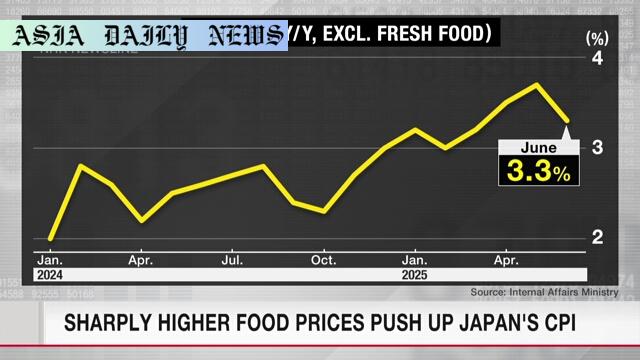Inflation: Japan’s consumer inflation, driven by a 100% rise in rice prices and substantial food costs, accelerates in June.
Japan’s consumer inflation in June increased by 3.3% year-on-year.
Food prices surged with rice prices doubling by 100%.
Other food items like coffee beans and chocolate rose 40%, while onigiri rice balls climbed 19%.
Government subsidies on gasoline slowed inflation for the first time in months.

Japan’s Inflation Sees a Surprising Surge in June
The cost of living in Japan took a significant upward turn in June as soaring food prices drove the country’s Consumer Price Index (CPI) higher. According to the Ministry of Internal Affairs, consumer inflation—excluding fresh food—rose by 3.3% year-on-year. This increase marks a continuation of inflationary pressures, which remain above the crucial 3% threshold despite government measures. While subsidies on gasoline slightly eased the overall inflation rate compared to previous months, food prices have continued their relentless climb.
Food Prices and the Unprecedented Rise of Rice Costs
The impact of inflation on Japan’s food sector has been particularly palpable, with prices of food products, excluding perishables, soaring by more than 8%. One of the standout figures in this rise is the price of rice, which has doubled—registering an unprecedented 100% increase compared to the previous year. However, the Ministry of Internal Affairs has clarified that its survey factors in only branded rice. The lower-priced grains released from government stockpiles were not included in this data, suggesting an even more complex picture of market trends.
Double-Digit Growth in Imports: Coffee, Chocolate, and Onigiri
In addition to skyrocketing rice prices, several other essential food items have also seen significant cost increases. Coffee beans and chocolate prices jumped approximately 40%, reflecting global supply chain challenges and raw material shortages. Meanwhile, the cost of convenience food items like onigiri (Japanese rice balls) climbed 19%, further burdening consumers’ wallets. As food staples and daily essentials become more expensive, household budgets across Japan face increasing pressure.
Government Subsidies and Economic Context
While the government’s efforts to subsidize gasoline have provided some respite, they have not been enough to counteract the overall rise in inflation. The nation’s economy remains vulnerable to global market fluctuations, particularly due to Japan’s reliance on imported goods. Combined with global disruptions in food supplies and raw material costs, economic uncertainty looms large over the country even after the moderation of energy costs. Economists warn that the underlying issues fueling inflation must be addressed to stabilize consumer prices in the long term.
What Lies Ahead for Consumers?
The sharp rise in food prices has raised concerns among consumers, policymakers, and industry experts alike. Prolonged inflation may lead to fundamental shifts in purchasing habits, with families potentially cutting back on staple items or seeking lower-cost alternatives. If global markets fail to stabilize, Japan may need to reassess its dependency on imports and seek domestic solutions to alleviate pressure on its economy. The coming months will be critical in determining whether recent inflation is a temporary spike or the start of a longer-term challenge for Japan’s economy and consumers.
Commentary
Understanding the Global and Local Drivers of Inflation
Japan’s rising inflation is a stark reminder of how interconnected the global economy has become. The staggering 3.3% rise in the Consumer Price Index reflects not just local challenges but the ripple effects of international market dynamics. The doubling of rice prices and significant increases in other food items further highlight the vulnerabilities of an economy reliant on imports. This situation invites reflection on how external factors such as global supply chain disruptions can directly affect household expenses.
The Impact on Japanese Households
For Japanese families, surging food prices mean tough decisions at the grocery aisle. Essentials like rice and coffee are no longer affordable staples but are rapidly approaching luxury status. This price hike is compounded by rising costs in other daily commodities like chocolate and onigiri rice balls, making a significant dent in household budgets. Families are faced with the dilemma of either cutting back on essentials or substituting preferred brands with lower-cost alternatives, potentially affecting their lifestyle and cultural habits.
Addressing Inflation Through Policy and Innovation
On the policy front, the Japanese government’s gasoline subsidies aim to moderate inflationary pressures. However, this band-aid approach cannot fully address widespread challenges like rising food prices. Policymakers should prioritize long-term strategies, such as investing in domestic agriculture, diversifying import sources, and creating a more resilient supply chain. Additionally, fostering innovation in food production and distribution could help alleviate the burden on consumers while ensuring sustainability in the future.
Global Lessons from Japan’s Inflationary Trends
Japan’s inflation trends serve as a cautionary tale for global economies. As nations grapple with fluctuating markets, import dependencies, and supply disruptions, the need for adaptive, forward-thinking solutions becomes clear. Collaborative international efforts to stabilize food markets and promote sustainable practices could provide a more secure foundation, not just for Japan but for the global community as a whole.


